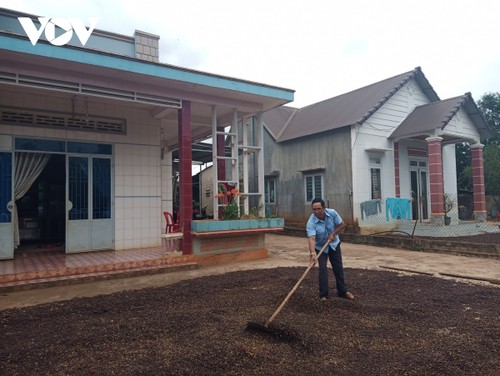
More concrete houses are built in Central Highlands hamlets. (photo: VOV)
|
We visited Ia Nan border commune in Gia Lai province just after a successful harvest. Families seem happy because their lives have changed for the better. They now live in concrete houses, and the commune now has adequate schools, clinics, clean water supply, and irrigation works.
Bùi Thị Thanh, Chairwoman of Ia Nam’s communal People’s Committee, says the commune began building a new rural area in 2011 and achieved all 19 new rural criteria by 2020. The annual income per capita here is more than 1,700 USD. The household poverty rate is less than 3%, Thanh said.
“Four years ago Ia Nan was an especially disadvantaged commune with a high poverty rate. Local authorities have organized training courses on production techniques and other vocations for the ethnic people of three hamlets, who have adopted new production methods. Each year we provide loans to poor, near poor, and ethnic households. They have used these resources efficiently.”
 Inter-hamlet roads are paved and lined with flowers. Inter-hamlet roads are paved and lined with flowers. |
Like other hamlets in the Central Highlands, Cư Dluê hamlet in Đắk Lắk province, has a pleasant appearance. Paved roads are shaded by trees and lined with flowers.
Villager Y Măt Byă says that the new rural area movement has changed people’s outlook and behavior: “There have been a lot of positive changes. People apply scientific knowledge to production, such as growing other plants under coffee trees. Families that don’t have farms work as hired labor. We tell each other to save money instead of living with an empty pocket.”
With stable incomes and better living conditions, people pay more attention to protecting their ethnic culture.
A project to preserve the Gong Culture of the Central Highlands and the recent National Brocade Festival in Đắk Nông province have promoted Central Highlands culture.
H’Đă Êya of Đắk Nông province, said that in response to the movement to build a cultural lifestyle, people wear traditional brocade clothes to weddings and festivals. Brides and grooms wear traditional costumes for their wedding photo albums. This has boosted the local brocade weaving craft.
“We don’t hesitate to wear brocade clothing. We wear E De costumes to festivals, weddings, and formal meetings. We hope the authorities will help us market our brocade products to people nationwide,” H’Đă Êya said.
The Central Highlands have seen encouraging results in building new rural areas. All the communes of Pleiku city and An Khe township in Gia Lai province have met the new rural criteria. Đắk Hà, Đắk Tô, Ngọc Hồi, and Kon Rẫy district in Kon Tum province have fulfilled their goals set for new rural communes. Lâm Đồng province has recognized 90% of 116 communes as new rural areas. Buôn Ma Thuột city in Đắk Lắk province is being verified for meeting new rural criteria.
Dieu Muu, Deputy Head of the Department of Locality II, Committee for Ethnic Minority Affairs, said: “It has been one of the most successful programs for agriculture and rural areas. Over the past decade, the rural economy has completely changed. Infrastructure has been upgraded systematically and public awareness has improved. It has had a good impact on people’s cultural life and tradition preservation. The program has also stabilized local politics and public security.”